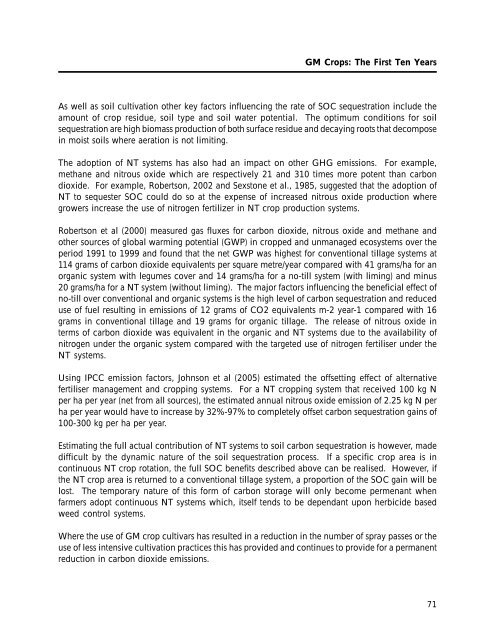GM Crops: The First Ten Years - International Service for the ...
GM Crops: The First Ten Years - International Service for the ...
GM Crops: The First Ten Years - International Service for the ...
You also want an ePaper? Increase the reach of your titles
YUMPU automatically turns print PDFs into web optimized ePapers that Google loves.
<strong>GM</strong> <strong>Crops</strong>: <strong>The</strong> <strong>First</strong> <strong>Ten</strong> <strong>Years</strong><br />
As well as soil cultivation o<strong>the</strong>r key factors influencing <strong>the</strong> rate of SOC sequestration include <strong>the</strong><br />
amount of crop residue, soil type and soil water potential. <strong>The</strong> optimum conditions <strong>for</strong> soil<br />
sequestration are high biomass production of both surface residue and decaying roots that decompose<br />
in moist soils where aeration is not limiting.<br />
<strong>The</strong> adoption of NT systems has also had an impact on o<strong>the</strong>r GHG emissions. For example,<br />
methane and nitrous oxide which are respectively 21 and 310 times more potent than carbon<br />
dioxide. For example, Robertson, 2002 and Sexstone et al., 1985, suggested that <strong>the</strong> adoption of<br />
NT to sequester SOC could do so at <strong>the</strong> expense of increased nitrous oxide production where<br />
growers increase <strong>the</strong> use of nitrogen fertilizer in NT crop production systems.<br />
Robertson et al (2000) measured gas fluxes <strong>for</strong> carbon dioxide, nitrous oxide and methane and<br />
o<strong>the</strong>r sources of global warming potential (GWP) in cropped and unmanaged ecosystems over <strong>the</strong><br />
period 1991 to 1999 and found that <strong>the</strong> net GWP was highest <strong>for</strong> conventional tillage systems at<br />
114 grams of carbon dioxide equivalents per square metre/year compared with 41 grams/ha <strong>for</strong> an<br />
organic system with legumes cover and 14 grams/ha <strong>for</strong> a no-till system (with liming) and minus<br />
20 grams/ha <strong>for</strong> a NT system (without liming). <strong>The</strong> major factors influencing <strong>the</strong> beneficial effect of<br />
no-till over conventional and organic systems is <strong>the</strong> high level of carbon sequestration and reduced<br />
use of fuel resulting in emissions of 12 grams of CO2 equivalents m-2 year-1 compared with 16<br />
grams in conventional tillage and 19 grams <strong>for</strong> organic tillage. <strong>The</strong> release of nitrous oxide in<br />
terms of carbon dioxide was equivalent in <strong>the</strong> organic and NT systems due to <strong>the</strong> availability of<br />
nitrogen under <strong>the</strong> organic system compared with <strong>the</strong> targeted use of nitrogen fertiliser under <strong>the</strong><br />
NT systems.<br />
Using IPCC emission factors, Johnson et al (2005) estimated <strong>the</strong> offsetting effect of alternative<br />
fertiliser management and cropping systems. For a NT cropping system that received 100 kg N<br />
per ha per year (net from all sources), <strong>the</strong> estimated annual nitrous oxide emission of 2.25 kg N per<br />
ha per year would have to increase by 32%-97% to completely offset carbon sequestration gains of<br />
100-300 kg per ha per year.<br />
Estimating <strong>the</strong> full actual contribution of NT systems to soil carbon sequestration is however, made<br />
difficult by <strong>the</strong> dynamic nature of <strong>the</strong> soil sequestration process. If a specific crop area is in<br />
continuous NT crop rotation, <strong>the</strong> full SOC benefits described above can be realised. However, if<br />
<strong>the</strong> NT crop area is returned to a conventional tillage system, a proportion of <strong>the</strong> SOC gain will be<br />
lost. <strong>The</strong> temporary nature of this <strong>for</strong>m of carbon storage will only become permenant when<br />
farmers adopt continuous NT systems which, itself tends to be dependant upon herbicide based<br />
weed control systems.<br />
Where <strong>the</strong> use of <strong>GM</strong> crop cultivars has resulted in a reduction in <strong>the</strong> number of spray passes or <strong>the</strong><br />
use of less intensive cultivation practices this has provided and continues to provide <strong>for</strong> a permanent<br />
reduction in carbon dioxide emissions.<br />
71
















